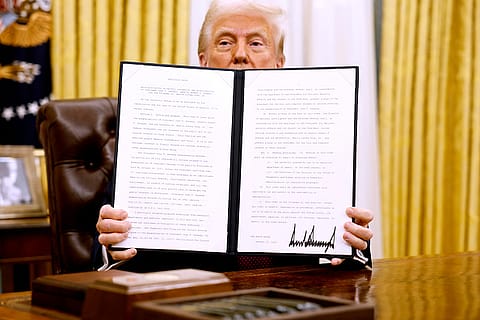Trump hints at scaling back 145% China tariff as U.S. signals softening stance on trade
Trump’s comments come at a time when the Secretary of the Treasury has acknowledged that the status-quo, 145% tariff rate is not sustainable, and has led to a situation like a trade embargo

The U.S. might renege on the aggressive tariffs it has imposed on China in an escalating and unwavering trade war—entailing in a fusillade of reciprocal, untenable tariffs from both countries and stoking fear and trepidation in the stock market—if a deal is reached between the two countries, President Donald Trump alluded to reporters at the Oval Office on Tuesday.
“145% is very high and it won’t be that high,” Trump said, before adding that it “won’t be anywhere near that high. It’ll come down substantially. But it won’t be zero,” referring to the current tariff rate that is in place, which was a culmination of the series of tariff threats that Washington and Beijing wielded at each other.
Trump also said that he is going to be “very nice” to China. “…and they’re going to be very nice, and we’ll see what happens,” he added. Trump’s comments come close on the heels of the Secretary of the Treasury Scott’s remarks at a private, closed-door investment conference hosted by J.P. Morgan, where he said that the tariff escalations between the two countries have virtually resulted in a situation like a trade embargo, according to the people who attended the conference.
Responding to the President’s comments, the Chinese Foreign Ministry said that the U.S., “can’t say it wants to reach an agreement with China and on the other hand keeps exerting extreme pressure,” adding that this is not the “right way to deal with China and it is not feasible.” Trump, when asked about Scott’s comments, said that the U.S. was doing “fine” with China, and does not anticipate a “hardball” negotiation.
The Ministry has exhorted the U.S. to constructively engage with China, with the intent of ‘equality’ and ‘mutual benefit’. “Such an approach was necessary for any future trade deal to take shape,” the ministry said. However, China remains open to the possibility of reaching a deal with the U.S. “We do not wish to fight, nor are we afraid of fighting,” foreign ministry spokesperson Guo Jiakun said at a scheduled press conference. “We will fight to the end, if necessary.”
According to Bloomberg, Bessent told the attendees that the current status quo of a 145% tariff rate is not sustainable, expressing optimism that the tensions between the countries could wane in the coming months, but a larger deal could take longer to fructify. A comprehensive deal, according to Bessent, between the two countries could happen between two to three years. Although Bessent clarified that any negotiations with China have not started yet.